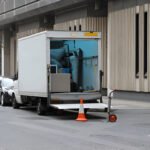Fire safety stands as a paramount concern in modern buildings. At the forefront of innovative solutions, fire curtains have emerged as a crucial component in comprehensive fire protection strategies. These advanced systems offer a seamless blend of safety and functionality, providing an effective barrier against the spread of flames and smoke during emergencies.
As building designs become more complex, the need for sophisticated fire safety measures continues to grow. Fire curtains work in tandem with other essential elements such as smoke detectors, fire walls, and fire alarm systems to enhance overall fire safety. They play a vital role in compartmentalization, helping to contain fires and protect evacuation routes. This article explores cutting-edge fire curtain technologies, their key features, and how they’re used in various building types to boost safety and save lives.
Types of Advanced Fire Curtain Systems
Advanced fire curtain systems play a crucial role in modern fire safety strategies, offering innovative solutions for various building types. These systems are designed to enhance compartmentalization and protect escape routes while maintaining esthetic appeal. Let’s explore three main types of advanced fire curtain systems:
Vertical Fire Curtains
Vertical fire curtains are a popular choice for commercial and industrial projects, such as shopping centers and office buildings. They are particularly useful in areas where maintaining large open spaces for access is necessary. These curtains are typically installed into ceilings and deploy vertically, making them ideal for floor-by-floor protection in multi-level buildings with large open areas like atriums, staircases, or escalators.
One of the key advantages of vertical fire curtains is their ability to remain hidden from view until deployment. This feature makes them an excellent option for designs that prioritize esthetics or need to conserve usable space. The DSI-C3HR Fire Protective Smoke Curtain is an example of an advanced vertical fire curtain system. It incorporates the latest electronic technology and is gravity fail-safe, making it one of the most advanced yet cost-effective systems available.
Horizontal Fire Curtains
Horizontal fire curtains are specifically designed to bisect atriums over two stories, effectively compartmentalizing smoke. They are particularly well-suited for multi-story buildings and can replace traditional fire protection equipment such as fire shutters, non-loadbearing firewalls, and fire-rated ceilings. This allows for the creation of modern, open multi-story ceiling voids while maintaining excellent fire compartmentation.
It’s worth noting that horizontal fire curtains are subject to unique regulations. ISO 21524 is the only product standard used in the UK with third-party certification from a Notified Body that specifically covers horizontal fire curtains. This certification ensures the reliability and effectiveness of these intricate systems in fire safety applications.
Concertina Fire Curtains
Concertina fire curtains are multi-sided vertical curtains that deploy from ceilings. They are ideal for shielding areas such as escalators and staircases, offering a versatile solution for open-plan building designs. One of the key advantages of concertina curtains is that they do not require side guides on corners, allowing for greater flexibility in architectural planning.
These curtains can also be used to create a reservoir for smoke on higher floors of atriums and other large spaces, enhancing overall fire safety. The DH60 concertina smoke curtain, for example, is third-party certified to EN12101, a certification achieved by only a handful of manufacturers.
Key Features of Modern Fire Curtains
Modern fire curtains have revolutionized building design, offering advanced protection and enabling complex structures to be safer. These innovative systems incorporate several key features that enhance their effectiveness in fire safety strategies.
Automatic Deployment
One of the most crucial features of modern fire curtains is their automatic deployment system. These curtains are designed to work in tandem with other fire protection systems, creating barriers where partitions are limited or absent. When a fire alarm is triggered, the system sends a signal to the fire curtain, causing it to drop from the ceiling. This automatic response prevents fire and smoke from spreading throughout the building, effectively compartmentalizing the affected area.
The mechanism behind this deployment is both robust and precise. Advanced engineering ensures that the curtain will function as intended when needed. To enhance reliability, a gravity fail-safe release mechanism is incorporated. This feature allows the curtain to descend even if the motorized control fails for any reason, ensuring protection in all scenarios.
Smoke Sealing Capabilities
Modern fire curtains excel in their ability to seal off areas from smoke infiltration. The SmokeShield® Fabric Smoke and Fire curtain, for example, boasts a UL1784 smoke and air infiltration listing. This certification demonstrates its effectiveness in preventing smoke spread, which is crucial for maintaining tenable conditions and allowing people time to use escape routes.
These curtains utilize patented technologies, such as GuideLock™, to positively seal the curtain within its guide channels. This feature ensures that smoke is cut off immediately after connected fire systems detect its presence, enhancing the overall safety of the building.
Fire Resistance Ratings
Fire resistance ratings are a critical aspect of modern fire curtains. These ratings indicate the amount of time a curtain can withstand standard fire exposure. The classifications are typically expressed in minutes, denoting the product’s performance under stipulated test conditions.
There are three main fire classifications:
- E (Integrity rating): Measures the curtain’s ability to prevent flames from passing through to the unexposed side.
- EW (Integrity and radiation rating): Assesses both integrity and the curtain’s ability to limit heat radiation.
- EI (Integrity and insulation rating): Considered the highest classification, it evaluates integrity and the curtain’s capacity to resist heat conduction.
Modern fire curtains often achieve high ratings in these classifications. For instance, some curtains offer a UL10D three-hour fire protection rating, demonstrating their ability to withstand intense fire conditions for extended periods.
Applications in Various Building Types
Fire curtains have become an integral part of fire safety systems across various building types, offering versatile solutions for different architectural needs. These innovative barriers play a crucial role in enhancing safety while maintaining esthetic appeal and functionality.
Commercial Buildings
In commercial settings, fire curtains have revolutionized fire safety strategies. Open-plan layouts, popular in modern office designs, often make traditional fire doors impractical. Fire curtains fill this gap by providing effective compartmentation without compromising the open feel of the space. They can be discreetly installed within ceilings and walls, remaining hidden until needed.
For retail stores, fire curtains offer a cost-effective and visually unobtrusive alternative to fire doors. They comply with strict safety standards such as BS 8524-1:2013, ensuring optimal protection. In shopping centers and office buildings, these curtains can be strategically placed to create fire barriers where walls are absent, enhancing overall safety without disrupting the flow of the space.
Industrial Facilities
Industrial settings benefit greatly from fire curtain technology. In manufacturing plants and warehouses, these curtains help compartmentalize vast spaces, effectively mitigating the spread of fire and smoke. This application aligns with key safety regulations, including the Health and Safety at Work Act 1974 and the Regulatory Reform (Fire Safety) Order 2005.
Fire curtains in industrial facilities serve multiple purposes:
- Limiting initial fire development
- Preventing fire spread
- Protecting escape routes
Their ability to suppress fire growth and smoke spread is particularly valuable in large, open industrial spaces where traditional compartmentation methods may be challenging to implement.
Public Spaces
In public spaces, fire curtains offer unique advantages. Theaters and cinemas have long utilized fire curtains to protect audiences without obstructing views, meeting the safety standards outlined in Building Regulations 2010 – Fire Safety Approved Document B.
Schools and educational facilities benefit from fire curtains in large communal areas like halls and dining spaces. These installations comply with the Department for Education’s Building Bulletin 100, enhancing safety in educational environments.
Hospitals present specific challenges that fire curtains address effectively. They maintain clear traffic flow, crucial for moving patients during emergencies, and cannot be propped open like traditional fire doors. This makes them ideal for controlled access points and isolation areas in healthcare settings.
Conclusion
Fire curtain technologies have come a long way, revolutionizing safety measures in modern buildings. These advanced systems offer a perfect blend of functionality and esthetics, allowing architects to create open, inviting spaces without compromising on fire safety. From vertical and horizontal curtains to concertina designs, these innovative solutions cater to various building types and architectural needs, enhancing overall fire protection strategies.
The key features of modern fire curtains, such as automatic deployment, smoke sealing capabilities, and high fire resistance ratings, make them an essential component in fire safety planning. Their versatility in applications across commercial, industrial, and public spaces showcases their adaptability and effectiveness. As building designs continue to evolve, fire curtains will undoubtedly play a crucial role in shaping safer environments, offering peace of mind to building owners, occupants, and fire safety professionals alike.
FAQs
What does the A1S Group specialize in?
The A1S Group is renowned for its role as a leading manufacturer, supplier, and installer of fire and smoke curtains, fire shutters, and industrial shutters.
How do fire shutters differ from fire curtains?
Fire shutters are made from interlocking steel slats, providing robust physical security and fire protection. In contrast, fire curtains are crafted from flame-resistant fabrics such as woven or stitched materials, primarily designed to stop the spread of fire and smoke but not suitable for security purposes.
Which curtains are effective in preventing fire spread?
Fire curtains are specifically designed to prevent the spread of fire and smoke within a building. They are made from heat-resistant materials like fiberglass and aramid, and are engineered to automatically deploy upon detecting fire through the fire alarm system, forming a fire-resistant barrier.
What constitutes an FM approved fire curtain?
An FM approved fire curtain features a flexible, fire-resistant fabric rolled around a circular tube. This curtain automatically deploys either when triggered by the fire alarm system or during a power loss, effectively blocking fire and smoke from spreading.











